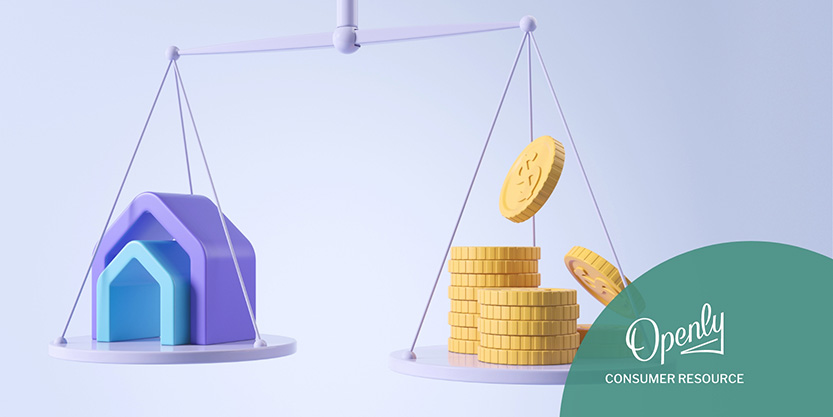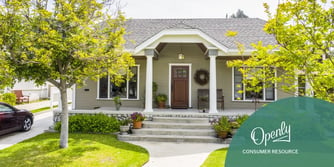Home sweet home! There's no place like it, and there's nothing quite like owning your own home. But with that ownership comes responsibility, and one of those responsibilities is protecting your home and personal belongings with homeowners insurance.
If you've ever asked yourself, "how much should my homeowners insurance cost?" then it's important to know that the answer to this question isn't a straightforward one, and the cost of homeowners insurance can vary greatly depending on a number of factors.
To understand how much homeowners insurance should cost, we’ll cover factors that affect costs, how they can be lowered and how to determine if you are getting enough value for the cost.
At a glance:
- The location, age, size of your home, and even your credit history can play a role in determining rates.
- Comprehensive policies may have higher rates but can reduce out-of-pocket costs.
- A homeowner can reduce costs by upgrading homes, choosing higher deductibles, and tailoring add-ons.
Factors that affect home insurance costs
For 2023, the average national cost of home insurance for a home valued at $300,000 was $1,899.1 There are several factors that can impact the cost of your homeowners insurance policy. The location, condition, age and size of your home, type of coverage, and even your credit history can all play a role in determining your insurance rate.
Location
We’ve all heard the old adage: “Location, location, location.” Well, when it comes to homeowners insurance, where you live can have a significant impact on the cost of your insurance rate.
Homes in areas that are more prone to natural disasters, such as hurricanes, earthquakes, or tornadoes, will typically have higher insurance rates than homes in more weather-stable locations.
Type of coverage
The type of coverage you choose will also affect the cost of your homeowners insurance. If you choose a comprehensive policy or a higher coverage level that protects a wider range of perils, it will generally cost more than a basic policy without the coverage bells and whistles. Some of these coverages include flood insurance or earthquake insurance, among others.
Condition of home
The condition of your home can impact the cost of your insurance, as well. Well-maintained and updated homes are less likely to suffer damage and will therefore have lower insurance rates.
Size of home
The size of your home will also play a role in determining your insurance cost. Larger homes are typically more expensive to insure due to the higher cost associated with repairing or replacing them in case of damage or loss.
Credit history
Believe it or not, your credit history or credit score can also influence the cost of your homeowners insurance coverage. People with good credit are often seen as more responsible and are therefore charged lower homeowners insurance rates than those with a poor credit score. This correlation between insurance and credit score is a key factor that many homeowners may not initially consider.
Claims history
A homeowner's claims history can significantly influence the insurance company's assessment of risk, often leading to adjustments in home insurance rates. Frequent claims may suggest a higher risk of future payouts, potentially increasing the average cost of insurance coverage.
Deductible amount
The deductible amount chosen by a homeowner affects dwelling coverage premiums, where opting for a higher deductible can lower home insurance rates. This choice directly impacts the insurance coverage's average cost, as it shifts some of the financial responsibility for damage or loss back to the homeowner, reducing the insurance company's potential payout on a claim.
Average home insurance cost by state
How much is the average homeowners insurance rate in my state? The cost of homeowners insurance depends on the variables outlined above but varies even further by state. For the purposes of this article, we will look at the average costs of a house with $250,000 in dwelling coverage, $250,000 in liability coverage, and a $1,000 policy deductible .
State variances for home insurance rates are often impacted by the propensity for extreme weather-related events, and not necessarily by popularity or desirability. Indeed, the state with the highest insurance premium might surprise you.
Coming in hot at more than 150% of the national average, Oklahoma is the most expensive state in which to insure a home, with an average annual premium of $3,659.2 Tornadoes and strong winds are common in the Sooner State, along with seismic activity in certain regions.
On the other end of the spectrum, is Hawaii with an average annual insurance rate of $382. But this low rate should be taken with a grain of salt. The majority of damage to homes in Hawaii is due to earthquakes and flooding, both of which are typically not covered by a standard home insurance policy.
Average home insurance cost by city
The cost of homeowners insurance can also vary by city. Cities with higher crime rates, for example, will have higher insurance rates than cities with lower crime rates.
Aligning with state variances regarding natural disasters, cities that are more prone to extreme weather will have higher insurance rates, while others still are impacted by the costs of labor and materials in the event of a rebuild.
The least expensive city to insure in the United States is located in Hawaii, while the most expensive city to insure is found in Florida with a whopping annual rate of $5,931—nearly 4x the national average!3
Average home insurance cost by coverage
The type of coverage you choose will also impact the cost of your homeowners insurance. A comprehensive policy, like an HO-5, will generally cost more than a more basic policy, like an HO-3.
HO-3 policies are the most common home insurance policies available and provide basic coverage levels, with the dwelling covered under open perils coverage, and personal property under named perils. HO-5 policies, meanwhile, are more comprehensive in nature and provide open perils coverage for both the dwelling and personal property.
It is important to note that not all insurers offer HO-5 policies, however, so if you are looking for the security and peace of mind that comes with a more premium and comprehensive insurance policy, talk with an independent insurance agent about Openly and see if they are a good fit for you.
Average home insurance cost by home age
The age of your home can also play a role in determining your insurance cost. Older homes tend to have higher insurance rates due to the higher likelihood of damage and the higher cost of repairs or replacement. Outdated wiring, inefficient appliances, older roofs and foundations can all affect the cost of insuring your home.
How to estimate the cost of insurance
When considering the average homeowners insurance cost, it's important to understand the factors that influence pricing, including replacement cost and personal property coverage. Accurately estimating these costs helps determine appropriate coverage limits and ensure your policy reflects the actual value of your home and belongings.
- Replacement Cost: Insurance companies calculate the replacement cost value (RCV) of your home, including any detached structures like sheds or garages. This amount helps insurance companies accurately assess the average cost to rebuild your home, and directly influences your home insurance rate.
- Personal Property Coverage: When estimating the cost to replace personal property, including items like clothing, furniture, appliances, and electronics, details, documentation, and photographs are key. Personal property coverage is a large part of your policy, and being accurate in your inventory will impact what the insurance company will reimburse you for—or how much out of pocket you may find yourself.
- Liability Coverage: Homeowners should take care not to limit the assessment of their needs to the tangible. Additional risks that may affect your home, such as liability, are equally important.
Be sure to discuss coverage options with your agent to obtain a more accurate estimate of home insurance rates from various home insurance providers. Due diligence will ensure you not only get your money's worth, but also have adequate protection.
What does a home insurance rate include?
So what does homeowners insurance cover? When discussing home insurance rates, it's important to understand the comprehensive nature of the coverage provided by homeowners insurance policies. These policies are designed to offer a wide range of protections, encompassing various aspects of home and personal liability:
- Dwelling Coverage is a fundamental component of home insurance that covers damage to the main house caused by insured events such as fires or hailstorms.
- Other Structures coverage extends your policy to structures on your property that are not attached to your house, such as fences or sheds.
- Personal Property coverage is an important element to your homeowners policy that provides compensation for damaged or stolen personal items.
- Loss of Use coverage also known as additional living expenses coverage) helps cover costs incurred if your home is deemed uninhabitable due to damage from a covered peril.
- Personal Liability coverage provides financial protection in the instance that someone is accidentally injured, or their property is damaged.
- Medical Payments Coverage caters specifically to the medical expenses for individuals who are injured on your property—regardless of who is at fault.
Tips to lower insurance premiums
While there are several factors that can increase your insurance rate, there are also several strategies you can use to lower your insurance premiums. Upgrades such as installing a new roof, replacing older electrical and plumbing systems, or adding security features and smart devices to monitor water leaks can help to reduce the risk of water damage and lower the cost of insurance.
Increase home security
Installing security features like monitored security systems, fire alarms, and smart water devices can help to reduce the risk of damage and lower insurance premiums.
According to Safewise, homes without security features are three times more likely to be burglarized.4 Insurers recognize this and will sometimes “reward” homeowners for taking the extra step to protect their homes with a security system with lower premiums.
Choose a higher deductible for loss of use
Choosing a higher deductible for loss of use coverage can help reduce the cost of home insurance. This coverage helps to pay for temporary housing if the home becomes uninhabitable due to a covered loss. By choosing a higher deductible, homeowners can reduce the cost of their insurance premiums.
Upgrades and improvements
Upgrades such as installing a new roof, upgrading electrical and plumbing systems, or replacing old appliances like water heaters, can help reduce the risk of damage and lower the cost of insurance.
Research insurance companies
Take the time to research different insurance companies and their policies. Look for companies with a good reputation for customer service and homeowner insurance claims handling, as well as policies that meet your coverage needs and budget.
Working with an independent home insurance agent can help you secure a policy that best suits your needs. Not only can they help you compare policies to find what is right for you, but they can also help you find a policy that provides the most bang for your buck.
Remember, a lower premium can also mean lower levels of coverage and you could end up paying more out-of-pocket than a more premium plan with higher levels of coverage. Sometimes the difference in cost is less than you’d think.
Lowering premiums doesn’t have to mean sacrificing coverage
Protecting your home is important, but it doesn’t have to break the bank. Understanding homeowners insurance coverage and the factors that influence your home insurance premiums, and taking steps to mitigate risks can help you lower the costs while still ensuring you have adequate protection for your most valuable asset.
*We provide this information to help you understand insurance. Any coverage is subject to the terms of your policy. Please refer to your policy and declaration page for complete coverage details.
1 Pat Howard. “Average home insurance costs by zip code in 2023.” Policygenius. 23 February 2023. Accessed 27 February 2023. https://www.policygenius.com/homeowners-insurance/home-insurance-rates-by-zip-code/
2 June Sham. “Home insurance rates by state for 2023.” Bankrate. 2 February 2023. Accessed 27 February 2023. http://www.bankrate.com/ insurance/homeowners-insurance/states/
3 Pat Howard. “Average home insurance costs by zip code in 2023.” Policygenius. 23 February 2023. Accessed 27 February 2023. https://www.policygenius.com/homeowners-insurance/home-insurance-rates-by-zip-code/
4 Celeste Tholen. “Can purchasing a home security system decrease my homeowners insurance?” Safewise. 12 April 2021. Accessed 27 February 2023. https://www.safewise.com/home-security-faq/homeowners-insurance/




